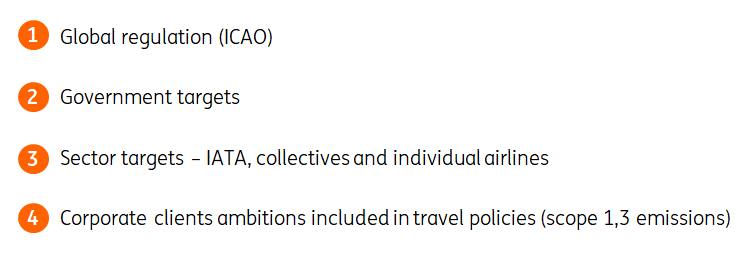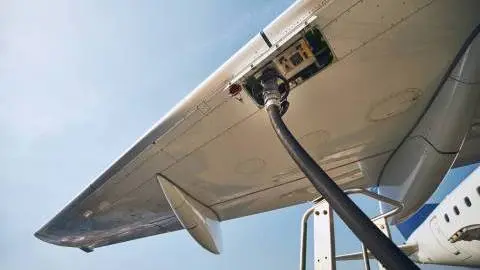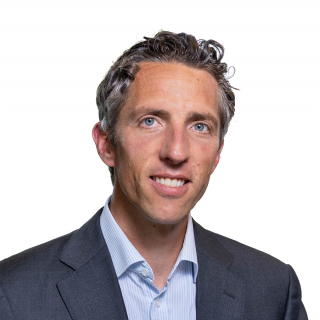Climate targets expedite the take-off of sustainable aviation fuels
It’s a pivotal time for sustainable aviation fuels (SAFs). Demand depends heavily on regulation and airline commitments, and blending is just starting off. But on the back of progressive target-setting for 2030, demand is about to accelerate. And this is necessary to curb and reduce net emissions, with airline traffic rebounding post-Covid
This article has been updated following the EU parliamentary adoption of amended blend fuel mandates last month.
SAFs may only seem a bridge solution for reducing net carbon emissions in aviation, but aviation is one of the hardest to abate sectors and new technologies won’t be mature anytime soon. SAFs offer the opportunity to reduce net emissions significantly and can ultimately be produced synthetically and almost free of emissions. Public authorities, airlines, and corporate customers increasingly push for SAFs, and they are approved as fuel under the global carbon offset and reduction scheme CORSIA. Global blending is still fractional at less than 0.1%, but acceleration is in progress and ambitions push for upscaling in the coming years, with the first target in Europe for 2025.
SAFs are still significantly more expensive. The US now provides incentives to drive production higher as part of the inflation reduction act. Incentives in other regions, as well as commitments to set in stone SAF targets from the global authority, the International Civil Aviation Organization (ICAO), could help support uptake.
Four main production routes of SAFs with net CO2 reductions from 70% to nearly 100%

Drop-in fuels with four main production routes and multiple feed stocks
Sustainable aviation fuel is jet fuel from a qualified renewable source which can be used by blending it into conventional jet fuel. SAFs require certification to be blended. The current maximum certified blend is 50%, but trials have been executed with a 100% usage of SAF, which is expected to be authorised in due course.
Of the four main production routes we distinguish, three are bioSAFS and one is synthetic (in this report we exclude direct combustion of liquid hydrogen). The extent to which a SAF reduces emissions depends on the lifecycle emissions profile of feedstock, considering production, transportation, and combustion.
CO2 emissions of global aviation have continued to grow over the last decade
CO2 emissions of global aviation in MT

The aviation sector is responsible for 2% of global greenhouse gas (GHG) emissions, but emissions have grown rapidly, and aviation is one of the hardest to abate sectors because of the required propulsion power and the importance of weight. The real climate impact (based on effective radiative forcing) could be larger due to emissions high in the atmosphere. The pandemic led to a temporary drop in emissions, but global airline demand is expected to recover from the pandemic before 2025 and will continue to grow at an annual pace of around 3-3.5% over the next few decades[1]. Consequently, emissions will barely come down. Despite efforts by the sector, the share of aviation’s CO2 emissions in the International Energy Agency's (IEA’s) net-zero emission scenario is expected to exceed 8% by 2040. This emphasises that change is required, in the short and long run.
[1] Based on multiple sources including: IEA, IATA, ICCT
Aviation's share of global emissions will rise significantly, even when including SAF blending
CO2 emissions of global aviation as % of (expected) global total emissions in the IEA's net-zero emission scenario (including an increasing blend of SAF)

Zero-emission aircraft not yet on the horizon in commercial aviation
Many articles and reports have been published about the future of flying, often suggesting that electric propulsion is already within reach. On the other hand, Airbus has explored direct hydrogen propulsion and announced plans to bring this aircraft concept for commercial purposes to the market in 2035. But technical ability doesn’t automatically mean the concept will be scalable and feasible to replace current commercial aircraft operations in the short run.
The energy density of batteries and hydrogen, possible lower expected speed, required spare capacity and not least extremely high specific safety standards pose a real challenge. "Zero-emission" flights powered by batteries or pure hydrogen might eventually be able to execute short-haul (regional) flights over the course of the next decade, but an efficient and commercially-viable zero-carbon alternative for current long-haul flights is not yet on the horizon. This builds the case for using SAFs and there are more reasons.
Multiple reasons why the aviation sector can’t wait for new zero-emission aircraft technology and need SAFs
- The largest part of total GHG emissions in aviation comes from long-haul flights, with hardly any alternatives.
- Safety always comes first in aviation. Together with technological complexity, this means future generation "zero-emission" aircraft will require billions in research and development and a long and time-consuming certification process with many years of preparatory testing.
- Airbus and Boeing have introduced a range of new-generation aircraft over the last decade and research and development cycles easily exceed a 10-year timeframe. Moreover, manufacturers still have extensive order books, with production backlogs running up to seven to eight years.
- The aircraft market is an oligopoly with Boeing and Airbus as dominant manufacturers. Challengers may disrupt the market, but given their power it’s likely that the incumbents will retain a dominant influence. An important point in this regard is that the development and ultimately successful introduction of a new commercial aircraft requires massive capital investments.
- Fleet replacement is slow and manufacturers currently face production constraints. Most of the current installed fleet will still be in operation in the 2030s.
- The aviation sector needs a solution that enables the current fleet to operate with lower net emissions and SAFs used as a drop-in fuel. Extra storage facilities at airports may be required, but regular infrastructure and current aircraft can be used, which is a major advantage that avoids massive capital loss.
Emissions from long haul flights and short term progression make SAFs crucial for decarbonisation
In practice, around 80% of global CO2 emissions emerge from flights travelling more than 1,500km, and in Europe around 50% of CO2 emissions are represented by long-haul flights of more than 4,000km (EASA). In several parts of the world including the US and Australia, these long-haul flights are even more important. For physical, security and economic reasons, a technology switch in commercial aviation is not within reach and this bolsters the case for sustainable aviation fuel. The three main short-term directions to decarbonise aviation are:
1. Fleet renewal/replacement by new generation aircraft.
2. More efficient operations.
3. Blending SAFs.
Fleet renewal and efficiency gains can contribute significantly to emission reductions, but SAFs are supposed to make the most difference in the medium term.
Global and government targets drive the uptake of SAFs
The production of SAFs is still 1.75-4.5 times as expensive as conventional jet fuel, depending on the type of SAF (REfuel aviation, EC). In most cases, customers are not willing to pay the (full) green premium on a voluntary basis. Research by ACM in The Netherlands showed that just over a third of customers are willing to pay for lower net CO2 emissions and just 10% have done so previously. Early-moving airlines take on responsibility, but a level playing field is required to push up consumption of SAFs and create economies of scale in production to bring down prices. Therefore, regulation is a critical support factor. This can either be done by taxing conventional kerosene (and redistributing the gains for decarbonisation) or subsidising SAFs.
Drivers of blending sustainable aviation fuel (SAF) – ambition framework

ICAO net-zero aspiration promising for pushing decarbonisation and SAF
Aviation is a sector with a global level playing field, therefore compelling policies ideally have a global scope. Due to regional differences and varying interests, ICAO struggled for a long time to agree upon climate targets aligning with the Paris agreement. After years of deliberation, in October of this year, ICAO finally succeed in adopting a net-zero emission target by 2050. This was a milestone achievement which shows support for increased production and blending of SAFs.
The general ICAO goal is aspirational, and the decarbonisation pathways and solutions are still to be developed, but it’s a signal and call to action. ICAO backs SAF and it seems reasonable to align with the ambitions of the airline association IATA. Implementation of ambitious global targets by ICAO would be most effective to push up SAF consumption.
Governments and sector representatives posed ambitious SAF blend targets for 2030
SAF blend mandates and targets for 2030 in % of total jet fuel consumption

Governments pursue a green recovery with setting blend targets for 2030
Government policies are the most direct regulatory drivers of SAFs. The past two years have been pivotal for increased urgency and ambitions, which led to pledges. Although the aviation sector went through an unprecedented crisis with steeply dropping passenger volumes over the pandemic, it has also been a catalyst for attempts to "build back greener" as the UK government called it. The EU already wants the blend to reach a level of 2% in 2025, which means consumption volumes will have to increase considerably in the years to come. Governments of larger advanced economies set targets to blend 6-15% of SAFs by 2030.
National ambitions of several European countries exceed the EU’s goals
The European Union still takes a relatively conservative approach in setting its SAF targets. Several other European countries had already established goals that are more ambitious than the EU’s 6% mandate for 2030, adopted as part of the RefuelEU aviation act. Member states including The Netherlands, Sweden and Finland earlier adopted SAF-targets of 14-30% for this decade, although the question raises if these still hold. The UK aims for a 10% blend of SAFs by 2030 and Norway aims for 30%.
US might take-over the lead from Europe in pushing SAFs
The US has also introduced its SAF strategy as part of its inflation-busting act, with an absolute production target of three billion gallons of SAF in 2030. Based on expected jet fuel consumption, this comes down to some 15% of total usage, and the ultimate goal is to replace the full 100% of future jet fuel consumption with SAFs. The US targets surpass the European ambitions in the medium term, as the EU forecasts a 2% blend in 2025 based on its REfuel Aviation plan, but a less aggressive path afterwards. However, the European ambitions also included a sub-target for synthetic fuels[2].
In addition, the US is offering a tax incentive of $1.25-1.75 per gallon of SAFs to push up production, which is critical for the fuels’ uptake. While Europe is generally leading in climate regulation, and may still choose to impose accompanying support or taxation measures and raise its targets later on, SAF production could grow at a faster pace in the US, at least this decade.
[2] As part of the general targets, Europe seeks to stimulate the development of synthetic SAF by setting sub-targets for the fuel mix from 2030 (1.2%, increasing to 5% in 2035 and 35% by 2050).
Decarbonisation ambitions also rely on massive future growth of SAFs
SAF blend target development per stakeholder in % of total jet fuel consumption

Sector initiatives set a voluntary standard, but show strategic commitment
Sustainability targets from airlines are an additional driving force from the private side. Global branch IATA adopted its net-zero 2050 target in 2021 and published its SAF strategy which aims for a 6% blend by 2030 and a 65% blend by 2050. Within the World Economic Forum, a significant number of airlines, airports, producers, original equipment manufacturers (OEMs) and corporate buyers teamed up in the "Clean skies for tomorrow" initiative in 2021, which focuses on accelerating SAF development in order to reach a 10% blend by 2030. In 2020, a group of airlines joined forces in the One World group to develop a SAF supply network. The largest European airline in passenger numbers – Ryanair – didn’t sign up for the collective initiative, but nevertheless aims for a 12.5% SAF blend by 2030.
Altogether, the number of airlines to adopt SAF targets has grown from just one (KLM) in early 2020 to more than 30 airlines in 2022, which shows a major acceleration in commitment.
Corporate clients’ climate commitments increasingly makes sense as the green premium needs to be paid
Airlines also have corporate clients that are increasingly aware of their responsibility in corporate travelling. Companies seek to reduce direct scope 1 or even scope 3 emissions of (long-haul) business travelling. This is regularly not a big share of emissions for manufacturing companies, but it does make sense for larger services companies active in, for example, consultancy, IT, or financial services.
On the air cargo side, it’s about decarbonising shipments for cargo owners. Global forwarder Kühne + Nagel, for instance, offers a 50% blend option for clients with ambitious climate reduction goals. And large logistics companies Fedex and DHL both set SAF targets of 30% by 2030.
Corporate clients can clearly support airlines on their journey, as SAFs are significantly more expensive than conventional jet fuel and the green premium needs to be paid.
It has been a while, but after two years of accelerated progress we believe that the regulatory and strategic landscape is ready for the take-off of SAFs, although the current goals aren’t legally binding and backed by sanctions. Demand is there and has to be matched by supply, which is challenging.
Download
Download article
11 May 2023
Sustainable aviation fuels play a critical role in future air travel This bundle contains 2 ArticlesThis publication has been prepared by ING solely for information purposes irrespective of a particular user's means, financial situation or investment objectives. The information does not constitute investment recommendation, and nor is it investment, legal or tax advice or an offer or solicitation to purchase or sell any financial instrument. Read more

